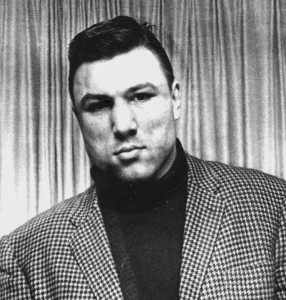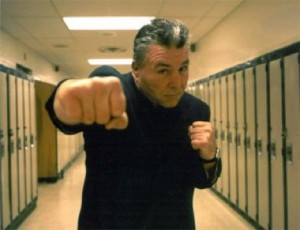George Chuvalo: He Fought (and Hurt!) Them ALL
 By Ian “The Boxing Historian” Murphy
By Ian “The Boxing Historian” Murphy
If I could think of one high-profile fighter off of the top of my head who was equal parts mismanaged, underrated and misunderstood, it has to be former Canadian Heavyweight Champion George Chuvalo. This is a man who fought at a time when the Heavyweight division was perhaps at its most competitive. He fought champions Muhammad Ali (2x), Joe Frazier, George Foreman, Floyd Patterson, Ernie Terrell (Chuvalo lost to him in a blatant robbery), and Jimmy Ellis. He also threw down with the era’s top contenders like Jerry Quarry, Yvonne Durelle, Zora Folley, Doug Jones, Oscar Bonavena, Mike DeJohn, and Cleveland Williams. He just missed out on fighting Sonny Liston. Chuvalo literally fought everyone of note during his long career. George backed away from nobody and even when he lost, he regularly beat the tar out of his opponents, and they, not he, often had to go to the hospital after the fight.
George’s career had a quick start, as he knocked out four men in one night during one of Jack Dempsey’s tournaments in the mid 1950s. However, he was managed by small timers who didn’t know how to properly handle a fighter with Chuvalo’s promise and ability. As a result, he was thrown in the deep end too early and too often, and had nearly half (7) of his career losses by the age of 23. When he became managed by Irv Ungerman and trained by Teddy McWhorter, his fortunes changed and he was able to train properly and gain more high profile fights. Chuvalo then solidified himself as a perennial top ten contender.
He fought former champion Floyd Patterson in 1965, and many felt that Chuvalo deserved the decision victory over the former champion. This match was not a robbery, but the fact that Patterson came from New York certainly did not hurt his chances at getting the nod from the judges. A year after the Patterson fight, Chuvalo finally got the break he was looking for: a fight against reigning champion Muhammad Ali for the World Heavyweight title (remember when there was one champ!?).
Most fans remember Ali’s fights with Frazier (classics, of course), Foreman, and the parade of fringe contenders he beat after the Thrilla in Manila in 1975. Yes, Ali showed tremendous heart and guile in those matches, but what gets lost is that he was far from his prime and lost his greatest weapon: his blinding speed. The 1966 version of “The Greatest” that George Chuvalo fought was Ali at his absolute best. Lightning quick, and hard punching (he didn’t have the hand troubles yet), that Ali was not the slower incarnation that most people remember from the mid 1970s. He was a freak of nature. Like a 6’3, 215lb butterfly with a baseball bat, Muhammad Ali was untouchable, literally. The man was nearly impossible to hit at that point in his career. Yet, most people forget that Chuvalo took “The Greatest” a full fifteen grueling rounds, and hurt Ali to the body so bad that he had to be hospitalized. George Chuvalo is the only fighter to give a prime Ali (1964-1967, pre banishment) a very tough fight. He lost, yes, and that is not disputed, but the tough and hard punching Chuvalo took everything Ali could dish out. Ali just blew through everyone else.
Underrated and Underappreciated
Chuvalo is underrated because most people look at his modest record of 73-18 and think he was just a tough “catcher” who hung in there with the greats of his era. What people often don’t know is that Chuvalo racked up 64 knockouts and fought seriously injured in some of his biggest fights. He fought an up and coming Joe Frazier in July, 1967 with an eye injury that he had suffered via headbutt the fight before. He trained through it, but the eye blew up on the regular. Frazier’s cannon of a left hook didn’t help matters, and the fight was stopped in the fourth round. The result was a TKO (like his later bout with George Foreman), but he did not get knocked off his feet. Chuvalo himself never said he would have beaten Frazier that night, but the fight was close, with Chuvalo even a head a little going into the third round. In the 3rd and 4th round, the eye swelled shut and Frazier’s big left hook sealed the deal. The referee stopped the match and Chuvalo lost. The payday was good, and he took the gamble. Chuvalo took nearly a year to recover from this career-threatening eye injury.
A year or so after his 1969 knockout of top contender Jerry Quarry, Chuvalo took on future champion George Foreman. Word was that Ali might be reinstated sometime that year (from his banishment due to his draft refusal), and the fighter he came back against was guaranteed a big payday. Chuvalo was ranked 4th in the world in early 1970, and would have been a good match for the former champion on his road back. Convinced by his management to take the fight with the up and coming Foreman (and being told Ali was not coming back), Chuvalo ran into a bad, bad man. This fight was a tough one, and Chuvalo was getting battered, but he was still in the fight when the ref stopped it in the third round. Irv Ungerman pleaded (foolishly) that the fight be stopped. Chuvalo (whose legs were steady) immediately became enraged and said to the ref “What the $*%*# was that?”, hardly the words and actions of a concussed fighter. Foreman was tiring (as he tended to do at that point in his career), and Chuvalo knew he needed to bide his time and absorb some punishment in order to win later on. He was not given the chance.
Chuvalo also demonstrated defensive skills that he was not known for due to his reputation of being a “catcher”. While he’ll never be mistaken for Willie Pep or Wilfred Benitez, George displayed good parrying and was especially adept at using that move to fire his vaunted left hook to the body. He also cut more than most due to glancing blows.  He also had an underrated jab that was less of a defensive tool and more of a set up to get his opponent moving backwards to he could get momentum on his crushing body blows. Chuvalo fought in an era when EVERYONE had a jab and knew how to use it to suit their style. Watch Chuvalo’s fight with Foreman, it isn’t so much Big George’s lethal hooks and uppercuts that hurt Chuvalo as it was his quick battering ram of a jab. Also, if Chuvalo took as many shots as people think he did, his brains would have been scrambled long ago, and he most certainly would have been knocked off his feet. As of today, at age 77, Chuvalo speaks clearly, and shows little signs of slurring or blank expression.
He also had an underrated jab that was less of a defensive tool and more of a set up to get his opponent moving backwards to he could get momentum on his crushing body blows. Chuvalo fought in an era when EVERYONE had a jab and knew how to use it to suit their style. Watch Chuvalo’s fight with Foreman, it isn’t so much Big George’s lethal hooks and uppercuts that hurt Chuvalo as it was his quick battering ram of a jab. Also, if Chuvalo took as many shots as people think he did, his brains would have been scrambled long ago, and he most certainly would have been knocked off his feet. As of today, at age 77, Chuvalo speaks clearly, and shows little signs of slurring or blank expression.
The “Real” Rocky Balboa
When most people think of the prototype for Stallone’s “Rocky”, they think of some sort of combination of Marciano, Frazier and Chuck Wepner. In reality, George Chuvalo represents the best model for the great fictional champion, especially when you look at how the man fought. Like the Italian Stallion, Chuvalo was a tough inside brawler, did the lion’s share of damage close up, and was known for his big left hand. He was a rough customer who was not opposed to getting a little dirty in a clinch. Like Balboa, Chuvalo was a murderous body puncher, often hospitalizing (Patterson and Ali are notable examples) his opponents over long and grueling fights. He almost never backed up, and kept constant pressure on his foes and took punishment to dish it out two-fold. George had a cast iron jaw, and was in excellent shape. Chuvalo was hell on wheels from the inside, tenderizing his foes like a butcher wielding a meat hammer.
Even though he never won the Heavyweight Championship during his long career, George Chuvalo (if he were 15 or 20 years younger) most certainly would have won a belt in the fractured 1980s title picture and had he been 10 years older, he would have been a terrific test for another hard-punching Iron Man: Rocky Marciano. Is there a heavyweight today that could deal with his particular kind of pressure and brutal body work? Absolutely not! While highly respected by his peers (Ali, Foreman and Co.), Chuvalo does not get the recognition amongst modern fight fans for what he was: a championship caliber fighter competing in the Heavyweight Division’s greatest era. Just look at his resume! Chuvalo gets credit for his toughness and thick whiskers (rightfully so, of course), but he was so much more than that, and one glance at who he fought should put the record straight.
[si-contact-form form=’2′]

